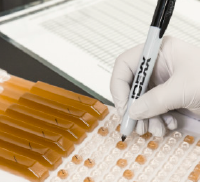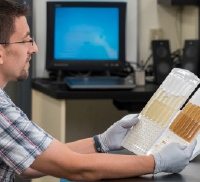
|

|
| New ways to reduce the risk of patient exposure to
Legionella pneumophila, the primary causative agent
of Legionnaires' disease |
| Legionnaires' disease cases have gone up by 400% in the last 14 years. Healthcare facilities are increasingly on the hook to reduce their patients' risk from this potentially deadly and highly preventable
form of pneumonia. New standards, The Joint Commission requirements, news coverage, legal battles, and million-dollar fines are making it clear that healthcare facility executives and managers are responsible for taking adequate prevention measures. |
|
|
|
 To reduce their risk, facilities must ensure their water safety management plans are effectively controlling Legionella pneumophila, the bacteria responsible for more than 95% of Legionnaires' disease cases1. Legiolert*, an accurate and extremely simple new culture-based test, opens the way for healthcare facilities to more quickly detect and respond to Legionella pneumophila on their premises. The Legiolert test can be performed in-house or by outside labs and provides a confirmed result for Legionella pneumophila in only seven days. To reduce their risk, facilities must ensure their water safety management plans are effectively controlling Legionella pneumophila, the bacteria responsible for more than 95% of Legionnaires' disease cases1. Legiolert*, an accurate and extremely simple new culture-based test, opens the way for healthcare facilities to more quickly detect and respond to Legionella pneumophila on their premises. The Legiolert test can be performed in-house or by outside labs and provides a confirmed result for Legionella pneumophila in only seven days.
Healthcare facilities' prevention responsibilities are being called out in recognized guidance documents.
The Joint Commission hospital accreditation Environment of Care standards require facilities to
"minimize pathogenic biological agents in cooling towers, domestic hot and cold water systems, and
other aerosolizing water systems." The Joint Commission surveyor's expectations specifically address
the prevention of legionellosis.
For the first time, 2015 American National Standards Institute (ANSI)/American Society of Heating,
Refrigerating, and Air-Conditioning Engineers (ASHRAE) 188 guidelines lay out a clear "standard of
care" for healthcare facilities. The Veterans Health Administration is leading the way among healthcare
systems, with explicit requirements for quarterly testing for Legionella pneumophila and mitigation
responses. Healthcare facilities can no longer ignore the risk of Legionnaires' disease.
 CDC, Occupational Safety and Health Administration
(OSHA), AHSRAE, and experts throughout the country agree
that an effective Water Safety Management Plan (WSMP) CDC, Occupational Safety and Health Administration
(OSHA), AHSRAE, and experts throughout the country agree
that an effective Water Safety Management Plan (WSMP)  is the key to reducing the risk of Legionnaires' disease. The
CDC recommends healthcare facilities have a WSMP for
both buildings' hot and cold water distribution systems and
highlights building areas with high potential for Legionella
growth and spread.
is the key to reducing the risk of Legionnaires' disease. The
CDC recommends healthcare facilities have a WSMP for
both buildings' hot and cold water distribution systems and
highlights building areas with high potential for Legionella
growth and spread. 
However, simply having a Water Safety Management Plan in
place is not enough to reduce disease risk.
|
|
|
"When you have a management plan, you need to make sure it works."
|
|
— 2016 CDC Water Management Plan Toolkit
|
|
Regularly testing for Legionella pneumophila, the bacteria responsible for the vast majority of Legionnaires' disease outbreaks  , is the only way to ensure that patients are not exposed to this
virulent pathogen. , is the only way to ensure that patients are not exposed to this
virulent pathogen.
Culture testing is the "gold standard" for Legionella detection, but has historically been the province of
specialized laboratories and required 10 to 14 days for a confirmed result. Legiolert is an easy culture
test for Legionella pneumophila with comparable accuracy and sensitivity to standard methods, but a
dramatically simpler procedure and a confirmed result in only seven days. Legiolert's shorter time to
results enables healthcare facility managers to respond more quickly to protect their patients when
Legionella pneumophila is found. At the same time, the ease of setting up and reading the Legiolert
test results means that hospitals have more testing options.
Learn more about Legiolert and preventing Legionnaires' disease.
|
Reference
1. European Centre for Disease Prevention and Control, Legionnaires' disease in Europe, 2014. ECDC; Stockholm:2016
|
|
|
|